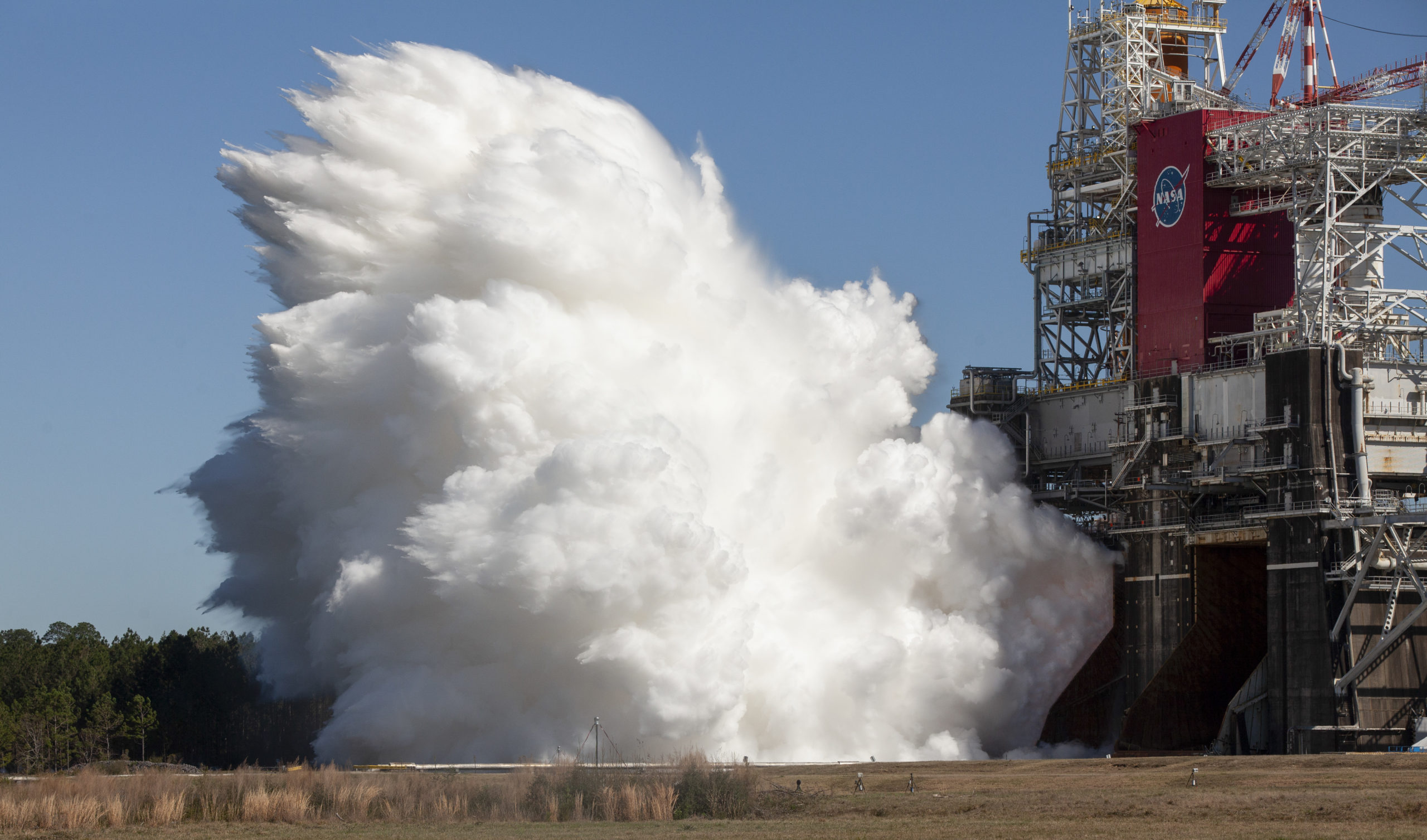
For SpaceUpClose.com & RocketSTEM
CAPE CANAVERAL, FL – NASA successfully completed the critical and long awaited hot test fire of the core stage engines for agencies the Space Launch System (SLS) human rated mega Moon rocket Thursday afternoon, March 18, on a test stand in Mississippi thus setting up its shipment to the Kennedy Space Center and paving the path for launch of the uncrewed Artemis-1 moon mission late this year or early next year followed by future Artemis missions with astronauts to orbit and land on the surface.
During the engine test dubbed the ‘Green Run’ the SLS core stage fired its four RS-25 engines for the full duration test period planned for a whopping 8 minutes and 19 seconds, nearly 500 seconds, and generated 1.6 million pounds of thrust with a huge billowing cloud of steam and smoke upon ignition Thursday at 4:37 p.m. EDT (3:37 p.m. CDT; 2037 GMT) at NASA’s Stennis Space Center B-2 test stand near Bay St. Louis, Mississippi and scored an “A+”, NASA officials said afterwards.
“Everything we’ve seen in the test today looked nominal, so I would say that the core stage got an A-plus today,” said John Honeycutt, the SLS program manager at NASA’s Marshall Space Flight Center in Huntsville, Alabama, at the post-test media briefing.
"The core stage got an A+ today."@NASA_SLS Manager John Honeycutt explains that all of the data from today's Green Run hot fire test looks nominal so far. There is still a lot more data to comb through in the coming days: pic.twitter.com/QW6Da1VC3f
— NASA (@NASA) March 18, 2021
The full duration 8 minute long Green Run test was finally completed on the 2nd try following a premature shutdown after just over 1 minute on the first try two months ago on Jan. 16.
A successful completion to the long awaited and absolutely critical Green Run hot fire test of all RS-25 four core stage engines simultaneously firing is essential for NASA to move forward with confidence with Project Artemis missions aimed at returning US astronauts to the moon and landing the first woman and next man as soon as late 2024.
Standing 212 feet tall (65-meter) , the SLS core stage is the largest rocket element NASA has ever built and SLS is the most powerful rocket the world has ever seen when it fires producing up to 8.8 million pounds of liftoff thrust fueled by over 700,000 gallons of cryogenic liquid oxygen and liquid hydrogen propellants
“What a great day, and a great test,” said NASA Acting Administrator Steve Jurczyk at the post-test media briefing.
“This is a major milestone advancing our goals for Artemis. I’m almost speechless at how well things went today.”
"What a great day and a great test… this is a major milestone for advancing our goals and objectives for #Artemis."
Acting Administrator Steve Jurczyk explains how our teams overcame the challenges of the global pandemic to successfully test the @NASA_SLS core stage: pic.twitter.com/5W1XufMvHt
— NASA (@NASA) March 18, 2021
Engineers designed the eight-part Green Run test campaign to gradually bring the SLS core stage to life for the first time, culminating with the hot fire. The team will use data from the tests to validate the core stage design for flight.
“The SLS is the most powerful rocket NASA has ever built, and during today’s test the core stage of the rocket generated more than 1.6 million pounds of thrust within seven seconds. The SLS is an incredible feat of engineering and the only rocket capable of powering America’s next-generation missions that will place the first woman and the next man on the Moon,” said Jurczyk.
“Today’s successful hot fire test of the core stage for the SLS is an important milestone in NASA’s goal to return humans to the lunar surface – and beyond.”
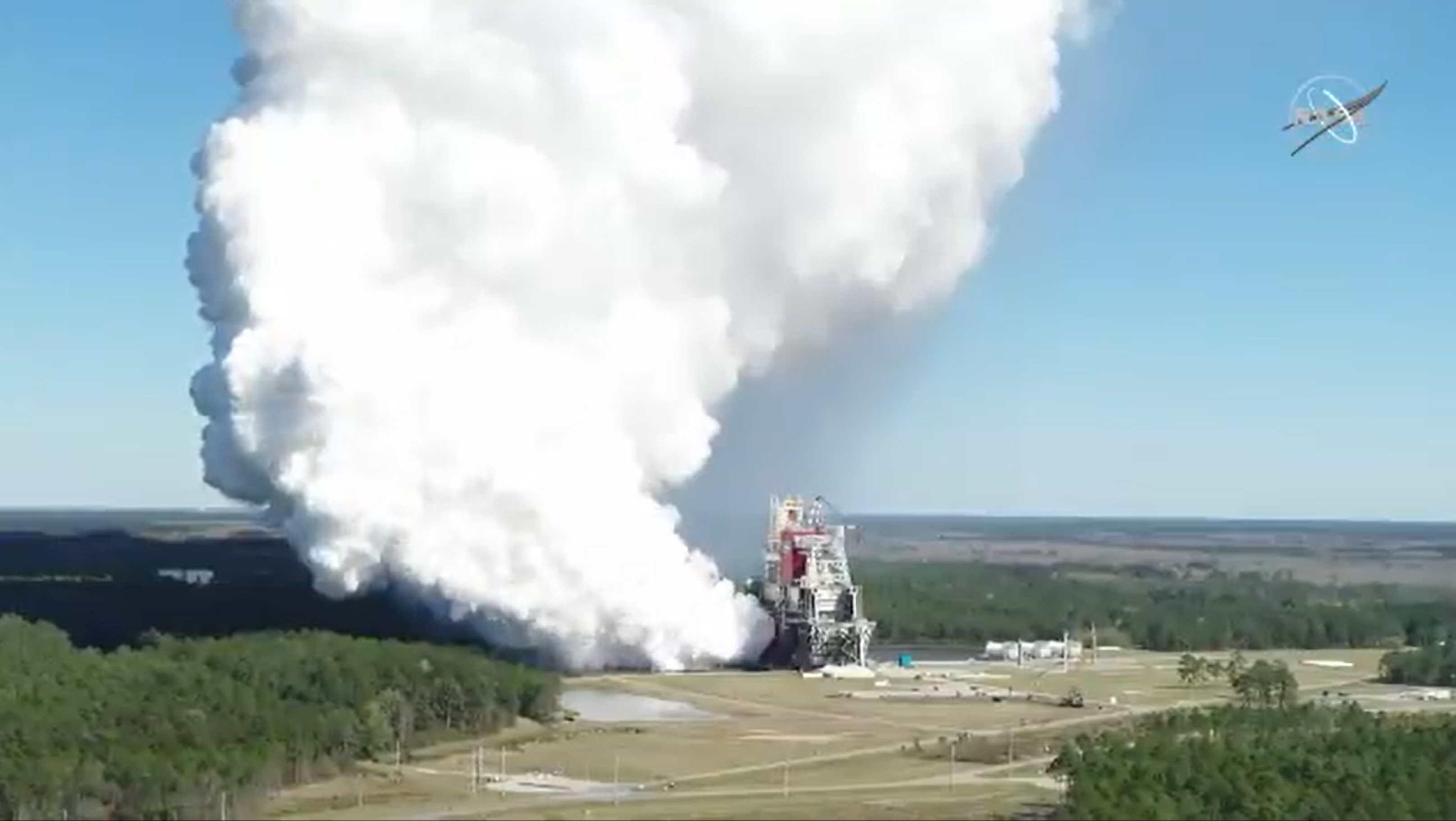
The Green Run test was carried live on NASA TV:
499.6 seconds.
That’s how long today’s successful Green Run hot fire test of the @NASA_SLS core stage lasted — providing enough data to determine if the stage is ready to be delivered to @NASAKennedy ahead of the #Artemis I mission: https://t.co/4CvC8wHUln pic.twitter.com/NJo2RiwhIG
— NASA (@NASA) March 18, 2021
The four RS-25 core stage engines were built and provided by Aerojet-Rocketdyne and are recycled and upgraded Space Shuttle main engines.
The 2nd Green Run hot fire test was conducted because the first test on Jan. 16 in the B-2 test stand at NASA’s Stennis Space Center only lasted about 67 seconds vs. the planned full duration test run of about eight minutes or approximately 485 seconds – the time it takes to achieve orbit.
NASA and prime contractor Boeing officials determined that the premature engine shutdown was “triggered by test parameters that were intentionally conservative to ensure the safety of the core stage during the test” involving a hydraulic system parameter.
Standing 212 feet tall, the SLS core stage is the largest rocket element NASA has ever built and SLS is the most powerful rocket the world had ever seen when it fires producing up to 8.8 million pounds of liftoff thrust fuel by over 700,000 gallons of cryogenic propellants liquid oxygen and liquid hydrogen,
The Green Run test series involves 8 major tests and is a comprehensive assessment of the rocket’s core stage prior to launching Artemis missions.
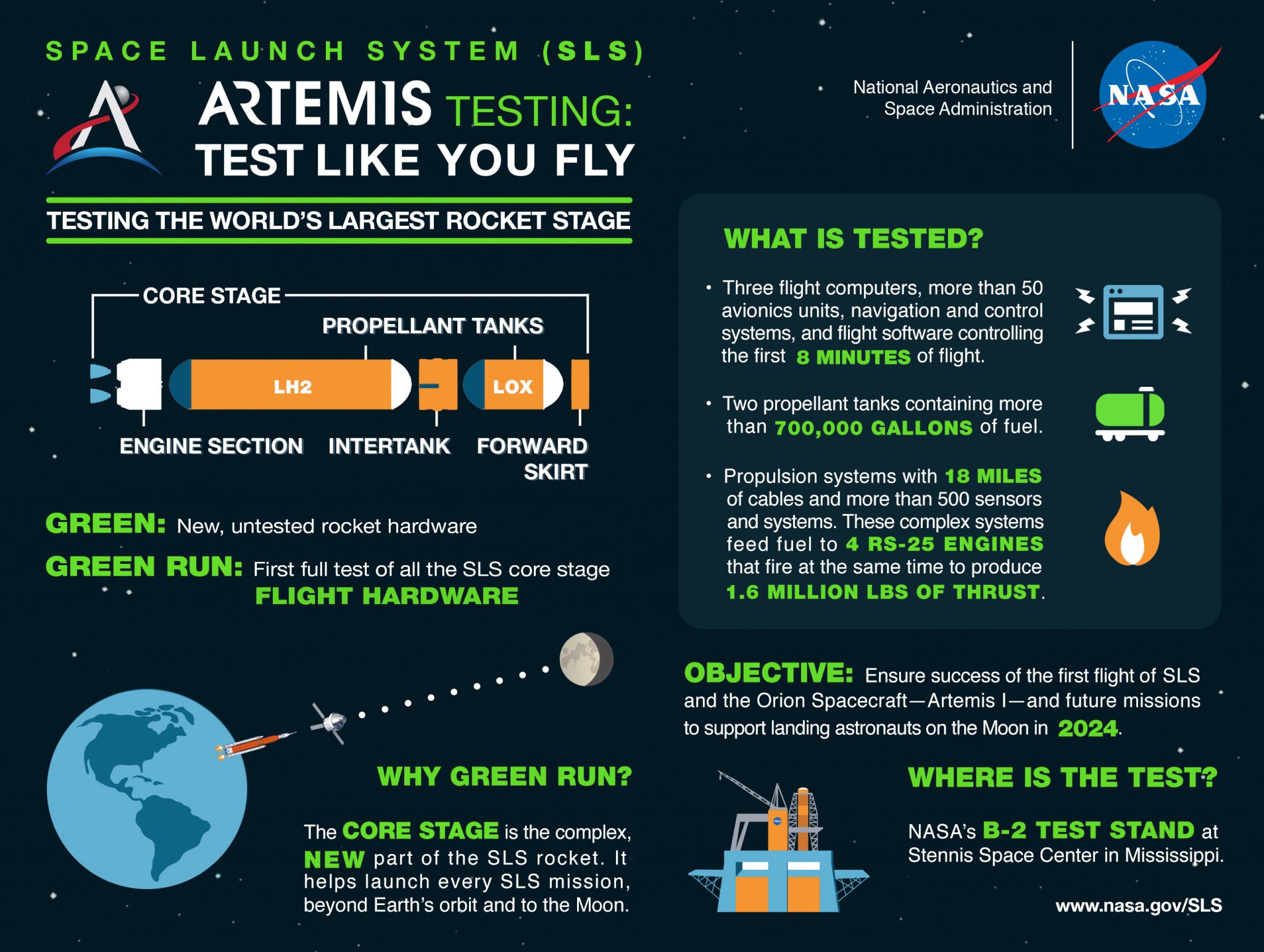
The NASA/Boeing/Aerojet Rocketdyne team opted to conduct the second hot fire test with a full duration of 8 minutes vs. just the 1 minute obtained in the 1st test in order to collect important data.
The longer duration hot fire tested a variety of operational conditions, including moving the four engines in specific patterns to direct thrust and powering the engines up to 109% power, throttling down and back up, as they will during flight, said officials.
Prior to and after the first test NASA and Boeing officials said they needed the test to run a minimum of about 250 seconds to obtain sufficient data to proceed ahead with the Artemis 1 mission.
Inspections of the core stage after the Jan 16 hot fire test revealed it to be “in excellent condition” with no significant repairs required
“This longer hot fire test provided the wealth of data we needed to ensure the SLS core stage can power every SLS rocket successfully,” said Honeycutt.
“During this test, the team conducted new operations with the core stage for the first time, repeated some critical operations, and recorded test data that will help us verify the core stage is ready for the first and future SLS flights for NASA’s Artemis program.”
Watch this short action-packed video recap from NASA:
Ready to see the world’s most powerful rocket come alive?
🚀 Watch this recap of our @NASA_SLS's hot fire test with all 4 of its engines firing, just as they will during the @NASAArtemis I launch to the Moon this year: https://t.co/lsjhVU9h30 pic.twitter.com/wdUqG0HCGN
— NASA (@NASA) March 19, 2021
The next steps are for the the core stage to be refurbished, then shipped to NASA’s Kennedy Space Center in Florida. At KSC the core stage will be assembled with the solid rocket boosters already stacked on the mobile launcher platform inside the Vehicle Assembly Building at Kennedy in preparation for Artemis I.
It should be ready for shipping on the Pegasus barge by mid to late April.
"By the end of April, we're looking at arriving to KSC."@NASA_SLS Stages Manager Julie Bassler explains what's next for the core stage: reviewing the data, refurbishing, and then shipping to @NASAKennedy to assemble with the other rocket elements ahead of #Artemis I. pic.twitter.com/KD5hsAUjX0
— NASA (@NASA) March 18, 2021
Meanwhile teams at KSC have been stacking the Artemis 1 SLS SRB boosters and have finished assembly of the Orion crew vehicle.
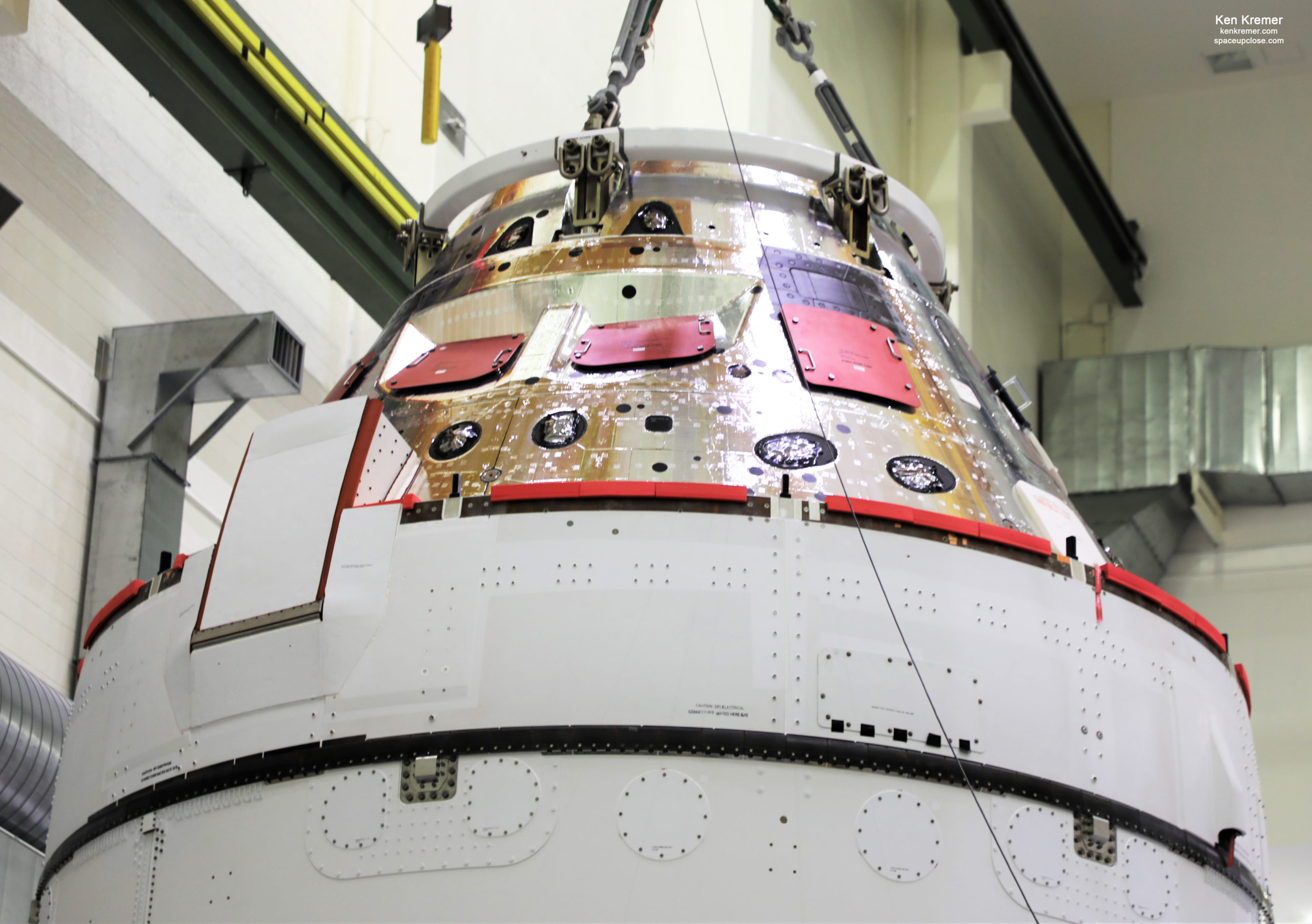
The SLS core stage for #Artemis I will arrive to @NASAKennedy following the Green Run hot fire test. A 325-ton crane will be used to stack the core stage on the mobile launcher to join it with the twin solid rocket boosters.
MORE ON LAUNCH PREP >> https://t.co/9SzQaBOROO pic.twitter.com/MlO663y7QE
— NASA_SLS (@NASA_SLS) March 16, 2021
My pre-test commentary about the Green Run hot fire was featured on WFTV ABC 9 Orlando TV News on March 17/18 and post-test on March 19.
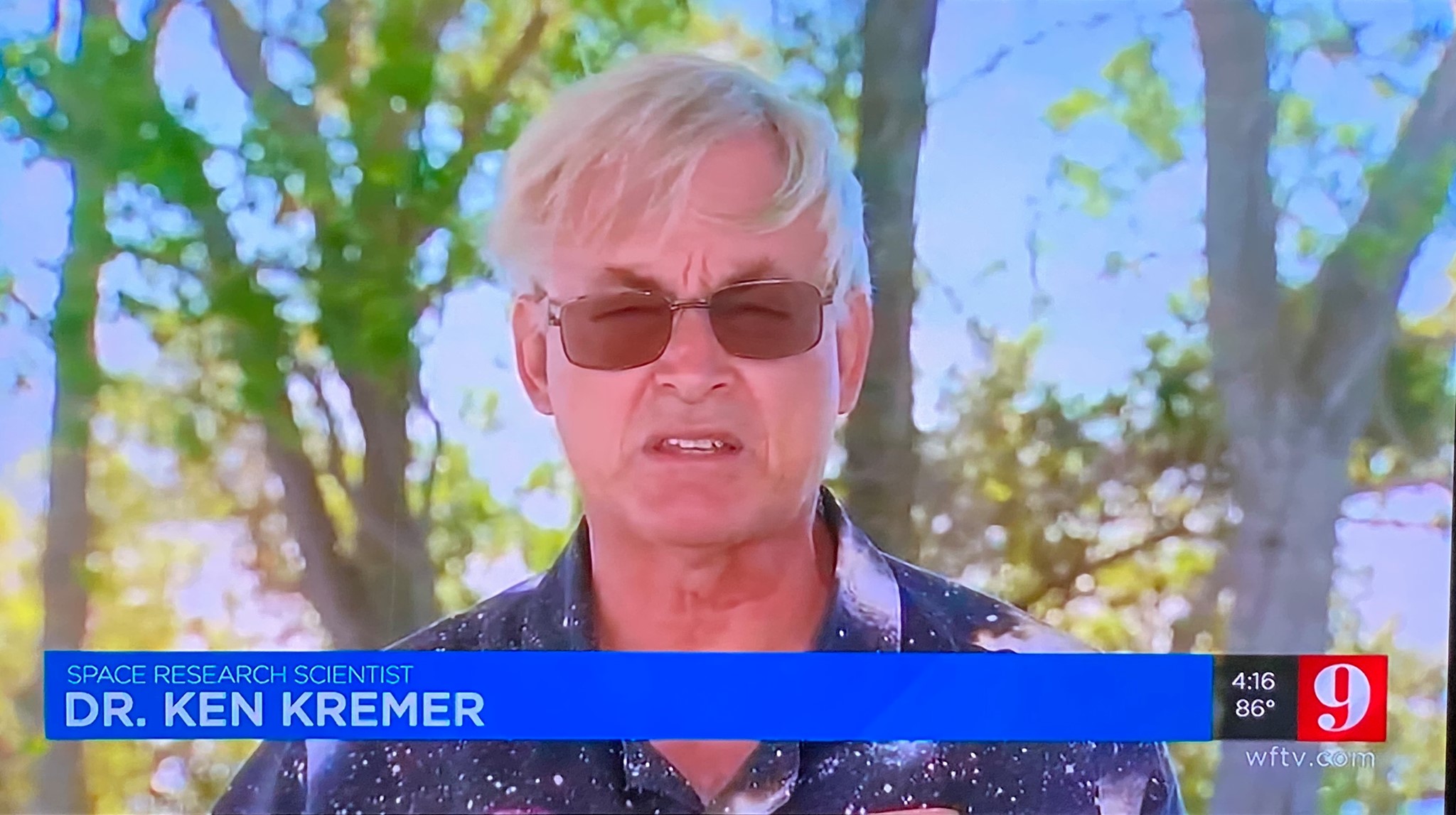
Watch Ken’s continuing reports about Artemis and NASA missions, SLS, Orion, SpaceX, Starlink, Commercial Crew and Starliner and Crew Dragon and onsite for live reporting of upcoming and recent SpaceX and ULA launches including Crew 1 & 2, Demo-2, ISS, X-37B, Solar Orbiter, Mars 2020 Perseverance and Curiosity rovers, NRO spysats and national security missions and more at the Kennedy Space Center and Cape Canaveral Space Force Station.
Stay tuned here for Ken’s continuing Earth and Planetary science and human spaceflight news: www.kenkremer.com –www.spaceupclose.com – twitter @ken_kremer – email: ken at kenkremer.com
Dr. Kremer is a research scientist and journalist based in the KSC area, active in outreach and interviewed regularly on TV and radio about space topics.
………….
Ken’s photos are for sale and he is available for lectures and outreach events
Please consider supporting Ken’s work by donating at Patreon:
https://www.patreon.com/kenkremer
x



